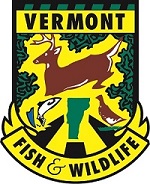
The winners of Vermont’s 2020 moose hunting permits were determined Wednesday, August 5, at a lottery drawing in Montpelier witnessed by Fish & Wildlife’s Director of Wildlife Mark Scott and Business Systems Analyst Cheri Waters.
The drawing is done by a random sort of applications that were submitted by a July 8 deadline.
As part of the regular lottery drawing, a “special priority drawing” was held for five permits to go to applicants who are Vermont resident veterans. The unsuccessful applicants from the veteran drawing were included in the larger regular drawing that followed. All applicants for both drawings who did not receive a permit were awarded a bonus point to improve their chances in future moose permit lotteries.
The department will issue 55 either-sex moose hunting permits in WMU-E in the northeast corner of the state for the moose seasons this October, which is expected to result in the harvest of 30-35 moose.
Winners in this year’s moose hunting lottery are posted in a searchable database on the Vermont Fish & Wildlife Department’s website (www.vtfishandwildlife.com).
If your name wasn’t drawn, you can still bid in Vermont’s auction for three moose hunting permits, which is open until August 12. Sealed bids must be received by Vermont Fish & Wildlife by 4:30 p.m. that day. Contact the Vermont Fish & Wildlife Department to receive a moose permit bid kit. Telephone 802-828-1190 or email (cheri.waters@vermont.gov).
“Moose density in WMU-E is more than one moose per square mile, significantly higher than any other part of the state,” said Nick Fortin, Vermont Fish & Wildlife’s biologist in charge of the moose project. “Moose densities greater than one per square mile support high numbers of winter ticks which negatively impact moose health and survival.”
Fish & Wildlife partnered with University of Vermont researchers to conduct a study of moose health and survival in WMU E. The results of this study, in which 126 moose (36 cows, 90 calves) were fitted with GPS tracking collars, clearly showed that chronic high winter tick loads have caused the health of moose in that part of the state to be very poor. Survival of adult moose remained relatively good, but birth rates were very low and less than half of the calves survived their first winter.
“Research has shown that lower moose densities, like in the rest of Vermont, support relatively few winter ticks that do not impact moose populations,” said Fortin. “Reducing moose density decreases the number of available hosts which in turn decreases the number of winter ticks on the landscape. The goal is to improve the health of moose in WMU E by reducing the impact of winter ticks.”
For Immediate Release: August 5, 2020
Media Contacts: Nick Fortin 802-793-8777; Mark Scott, 802-777-4217
